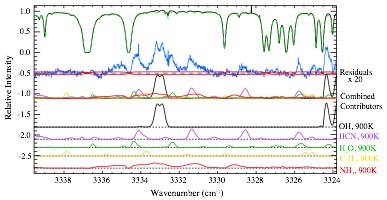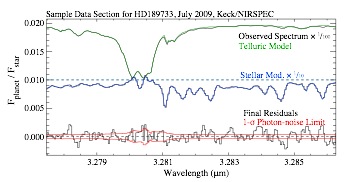2010 Annual Science Report
 NASA Goddard Space Flight Center
Reporting | SEP 2009 – AUG 2010
NASA Goddard Space Flight Center
Reporting | SEP 2009 – AUG 2010
NIR Spectroscopic Observations of Circumstellar Disks Around Young Stars
Project Summary
Using the NIRSPEC instrument on the Keck telescope in collaboration with Dr. Michael Mumma of NASA GSFC and Dr. Geoffrey Blake of CalTech, we made the first discovery of OH ro-vibrational emission in the L band (3 – 4 μm) in the planet-forming (1-10 AU) region of disks around Herbig Ae stars (Mandell et al. 2008). OH is a sensitive tracer of the UV and IR radiation field and the dissociation and recombination of H2 and H2O, and combined with a strong upper limit for H2O emission these observations provide a sensitive constraint on the formation and destruction rate of water and the vertical height of the dust absorbing layer. Line strengths are characteristic of temperatures of ~600K, and the location is constrained to beyond ~1 AU by the spectral line widths, suggesting we are observing the warm molecular layer beyond the inner dust rim.
Project Progress
NIR Spectroscopic Observations of Circumstellar Disks Around Young Stars
Using the NIRSPEC instrument on the Keck telescope in collaboration with Dr. Michael Mumma of NASA GSFC and Dr. Geoffrey Blake of CalTech, we made the first discovery of OH ro-vibrational emission in the L band (3 – 4 μm) in the planet-forming (1-10 AU) region of disks around Herbig Ae stars (Mandell et al. 2008). OH is a sensitive tracer of the UV and IR radiation field and the dissociation and recombination of H2 and H2O, and combined with a strong upper limit for H2O emission these observations provide a sensitive constraint on the formation and destruction rate of water and the vertical height of the dust absorbing layer. Line strengths are characteristic of temperatures of ~600K, and the location is constrained to beyond ~1 AU by the spectral line widths, suggesting we are observing the warm molecular layer beyond the inner dust rim.
We are now extending this work to characterize a wide range of molecular species such as H2O, OH, CH4, NH3, C2H2, and HCN in disks of different masses and ages in order to better understand the chemical balance and thermal conditions in different environments and evolutionary states. We have successfully detected HCN and C2H2 in the L band for the first time in the T Tauri star AS 205 A (Mandell et al. 2010, in prep; Fig. 1), and combined with sensitive upper limits for CH4 in another bright T Tauri star, we can constrain the emitting region to close to 1 AU. Measuring multiple molecular tracers in one source (HCN, H2O, OH, and C2H2) allows us to accurately compare quantities such as the relative Doppler velocity shifts and molecular abundances, and preliminary analysis suggests there may be two separate velocity components – a disk component in Keplerian rotation around the star, and a slow disk wind that is being released from the surface of the disk.
These new molecular gas tracers will allow us to constrain the disk conditions in the region where planets are forming, providing information on disk structure (e.g. inner gas evacuation, vertical temperature gradient, and dust coagulation timescales) and composition (e.g. condensation fronts, C/O ratio) and aiding in further improvements to computational planet formation and disk evolution models. This work will also lay the groundwork for observations of circumstellar disks with the next generation of near-IR and mid-IR instruments.

Figure 1. Figure 1. Section of L-band spectrum for the T Tauri star AS205 taken with the CRIRES spectrograph on the Very Large Telescope. Residuals reach a S/N ~ 500 and show features from 5 different molecules, several of which have not previously been detected at these wavelengths.
Ground-based Spectroscopy of Exo-planet Atmospheres
We are now initiating a study to use the high-resolution, high-contrast spectroscopic techniques I have developed to characterize NIR emission from the atmospheres of known extra-solar “hot Jupiter” planets. Numerous previous ground-based searches for exo-planet signatures in the near infrared (primarily at 2.1 μm) have been unsuccessful, but planet-star flux ratios in the L-band (3 – 4 μm) are 10 times larger and absorption lines are prominent over a large range in wavelength, and at high resolution we can use the Doppler shift of the planet over time to remove stellar features and pull out the planetary spectrum. This technique can be used for both transiting and non-transiting planets, making it especially useful for probing a wide range of planetary orbit parameter space.
Preliminary data were taken in 2009 with NIRSPEC on Keck. Early reductions demonstrate that we can successfully reach the required S/N may contain potential molecular features from the planetary atmosphere (Figure 2; Mandell et al. 2011 in prep.), but the systematic uncertainties must be quantified further and more verification checks are necessary to better constrain any detected features. A successful detection will be a major milestone in exo-planet science –it would be the first spectrum of an exo-planet from the ground, and the high resolving power (R ~ 25,000) would allow us to isolate specific spectral lines formed over a range of height in the atmosphere and quantify temperature versus vertical height for a range of molecules. We can measure a wide range of molecules such as H2O, CH4, and other hydrocarbons, and characterize the presence and formation height of any strongly-absorbing atmospheric absorbers, which are theorized to lead to variations in temperature structure seen by Spitzer photometry. We can also break the mass-inclination degeneracy for non-transiting planets by determining the inclination of the orbit from the velocity shift of the planetary features, an important factor usually thought to require difficult astrometric observations.
Even before we have conclusively detected the planet, we can rule out a detection of the strong emission feature at 3.25 μm that was recently reported in the journal Nature. Using low resolution spectroscopy, Swain et al. (2010) reported a detection of a very bright emission feature extending from 3.1 to 3.5 μm; the authors attributed it to non-LTE emission from methane in the planet’s atmosphere. Our data probes a portion of the wavelength spectrum near the peak of the reported emission, and with high-resolution spectra the expected emission lines should be 40 times stronger than our uncertainly limits. We see no sign of any emission, with the most likely explanation being that Swain et al. did not properly account for changes in the water vapor in our own atmosphere (Mandell et al. 2010, submitted).

Figure 2. Figure 2. Section of L-band spectrum for the exo-planet host star HD189733 taken with the NIRSPEC spectrograph on the Keck Telescope. Residuals reach a S/N ~ 1500, and several features may be evidence of molecular absorption in the planet atmosphere (pending confirmation). This would be the first spectrum of an exo-planet from the ground.
-
PROJECT INVESTIGATORS:
-
RELATED OBJECTIVES:
Objective 1.1
Formation and evolution of habitable planets.
Objective 1.2
Indirect and direct astronomical observations of extrasolar habitable planets.
Objective 3.1
Sources of prebiotic materials and catalysts
Objective 7.2
Biosignatures to be sought in nearby planetary systems
